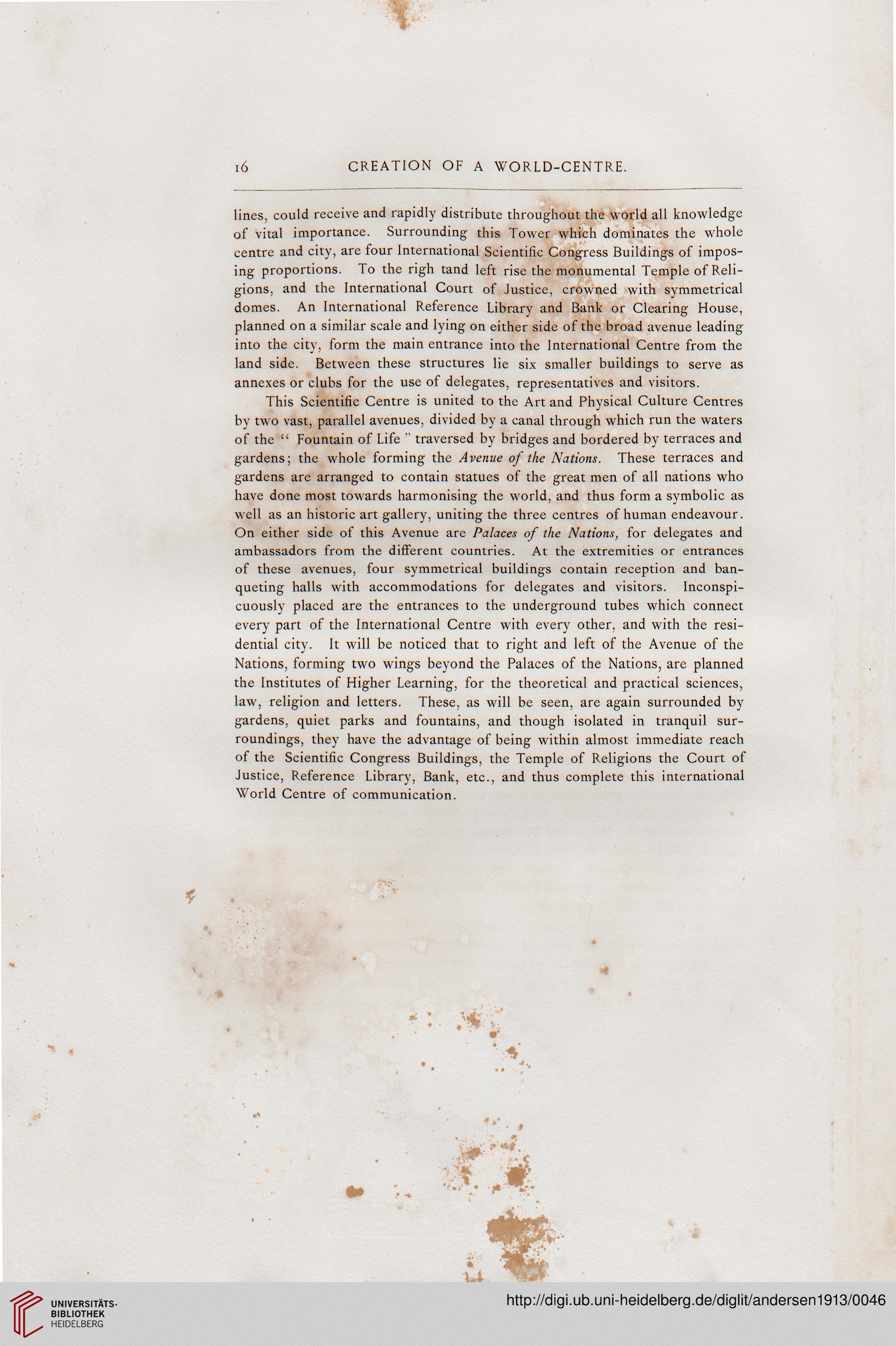i6
CREATION OF A WORLD-CENTRE.
lines, could receive and rapidly distribute throughout the world all knowledge
of vital importance. Surrounding this Tower which dominates the whole
centre and city, are four International Scientific Congress Buildings of impos-
ing proportions. To the righ tand left rise the monumental Temple of Reli-
gions, and the International Court of Justice, crowned with symmetrical
domes. An International Reference Library and Bank or Clearing House,
planned on a similar scale and lying on either side of the broad avenue leading
into the citv, form the main entrance into the International Centre from the
land side. Between these structures lie six smaller buildings to serve as
annexes or clubs for the use of delegates, representatives and visitors.
This Scientific Centre is united to the Art and Physical Culture Centres
by two vast, parallel avenues, divided by a canal through which run the waters
of the " Fountain of Life " traversed by bridges and bordered by terraces and
gardens; the whole forming the Avenue of the Nations. These terraces and
gardens are arranged to contain statues of the great men of all nations who
have done most towards harmonising the world, and thus form a symbolic as
well as an historic art gallery, uniting the three centres of human endeavour.
On either side of this Avenue are Palaces of the Nations, for delegates and
ambassadors from the different countries. At the extremities or entrances
of these avenues, four symmetrical buildings contain reception and ban-
queting halls with accommodations for delegates and visitors. Inconspi-
cuously placed are the entrances to the underground tubes which connect
every part of the International Centre with every other, and with the resi-
dential city. It will be noticed that to right and left of the Avenue of the
Nations, forming two wings beyond the Palaces of the Nations, are planned
the Institutes of Higher Learning, for the theoretical and practical sciences,
law, religion and letters. These, as will be seen, are again surrounded by
gardens, quiet parks and fountains, and though isolated in tranquil sur-
roundings, they have the advantage of being within almost immediate reach
of the Scientific Congress Buildings, the Temple of Religions the Court of
Justice, Reference Library, Bank, etc., and thus complete this international
World Centre of communication.
4
CREATION OF A WORLD-CENTRE.
lines, could receive and rapidly distribute throughout the world all knowledge
of vital importance. Surrounding this Tower which dominates the whole
centre and city, are four International Scientific Congress Buildings of impos-
ing proportions. To the righ tand left rise the monumental Temple of Reli-
gions, and the International Court of Justice, crowned with symmetrical
domes. An International Reference Library and Bank or Clearing House,
planned on a similar scale and lying on either side of the broad avenue leading
into the citv, form the main entrance into the International Centre from the
land side. Between these structures lie six smaller buildings to serve as
annexes or clubs for the use of delegates, representatives and visitors.
This Scientific Centre is united to the Art and Physical Culture Centres
by two vast, parallel avenues, divided by a canal through which run the waters
of the " Fountain of Life " traversed by bridges and bordered by terraces and
gardens; the whole forming the Avenue of the Nations. These terraces and
gardens are arranged to contain statues of the great men of all nations who
have done most towards harmonising the world, and thus form a symbolic as
well as an historic art gallery, uniting the three centres of human endeavour.
On either side of this Avenue are Palaces of the Nations, for delegates and
ambassadors from the different countries. At the extremities or entrances
of these avenues, four symmetrical buildings contain reception and ban-
queting halls with accommodations for delegates and visitors. Inconspi-
cuously placed are the entrances to the underground tubes which connect
every part of the International Centre with every other, and with the resi-
dential city. It will be noticed that to right and left of the Avenue of the
Nations, forming two wings beyond the Palaces of the Nations, are planned
the Institutes of Higher Learning, for the theoretical and practical sciences,
law, religion and letters. These, as will be seen, are again surrounded by
gardens, quiet parks and fountains, and though isolated in tranquil sur-
roundings, they have the advantage of being within almost immediate reach
of the Scientific Congress Buildings, the Temple of Religions the Court of
Justice, Reference Library, Bank, etc., and thus complete this international
World Centre of communication.
4





